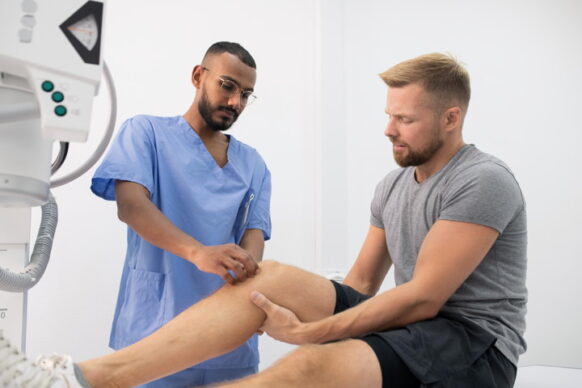Osteoporosis: Get an Early Diagnosis with a DEXA Scan

Of all the conditions common amongst aging individuals, osteoporosis is one of, if not the most common. Fully half of all women in the US over 50 years of age will suffer an osteoporosis-related fracture, and one in four men over the age of 50 will break a bone due to the condition.
While there is no known way to reverse the negative effects of osteoporosis, there are treatments that can slow its progress and keep older individuals active and healthy. Of course, as with treatment for most conditions, early detection is the key to successful outcomes. The longer an osteoporosis sufferer’s condition goes undiagnosed, the less effective treatment will be and the higher the risk for injury.
What Is Osteoporosis?
At different stages of life, the body’s ability to grow new bone tissue decreases. From childhood until our late 20s, the body produces more bone than it loses, resulting in a gradual increase in bone mass.
At around age 30, the body stops producing new bone tissue as readily. While new tissue is still being created, it’s not being created as quickly as old bone tissue is lost.
As we grow past our forties and into our fifties, that bone loss can be severe enough to cause the bones to become soft and brittle. Once the loss has reached a certain stage, an individual is said to be suffering from osteoporosis.
What Are the Warning Signs of Osteoporosis?

Osteoporosis is often referred to as a “silent disease,” since the deterioration of the bone tissue isn’t marked by pain or any other acute symptoms. Most people don’t know they’re suffering from the condition until a minor fall or other impact causes a fracture.
There are, however, usually a number of warning signs that can indicate when someone’s bone tissue has deteriorated to the point of osteoporosis:
Loss of Height
As we age, the cartilage in our spines begins to lose density and compress, causing us to get shorter over time. This normal height loss, however, usually amounts to less than an inch lost in total.
If you’ve lost more than an inch and a half of height, you could be suffering the effects of osteoporosis causing the vertebrae in your spine to compress and collapse.
Curved Upper Back
A hunched or even humped upper back can be another warning sign for osteoporosis. Weakened bone structure in the thoracic spine can cause these vertebrae to collapse, leading to the curvature.
This curvature is known as dorsal kyphosis and may also be indicative of other medical conditions.
Sudden Back Pain
Compression fractures in the spine often result in sudden, unexplained back pain. This pain will usually be centered in the mid or lower back.
If you’ve experienced back pain without any apparent cause or severe back pain that’s noticeably worse than your activity level would suggest, that could indicate osteoporosis.
Dental Issues
Teeth are bones, too. As the jawbone loses density, it can lead to various dental issues, including:
- Loose teeth
- Loose-fitting dentures
- Receding gums
If you begin experiencing these kinds of issues and there’s no apparent oral health cause, you may be suffering from osteoporosis.
Gastrointestinal Problems
If you’ve suffered from osteoporosis-related compression fractures in your lower back, that can actually cause gastrointestinal problems as your thoracic organs (ribs, lungs, etc.) intrude into the space occupied by your stomach and intestines. These issues can include:
- Reduced appetite
- Constipation
- Bloating
- Abdominal pain
Early Osteoporosis Diagnosis with DEXA Scans from OrthoGeorgia
While almost all of these symptoms can be caused by a number of medical conditions, if you’re over age 50, they should prompt you to get your bone health checked out.
Fortunately, the best test for osteoporosis is quick and painless. A DEXA (Dual-Energy X-ray Absorptiometry) scan only takes a few minutes and doesn’t require any special preparation. A specially tuned pair of x-ray emitters will scan across your body using very low levels of radiation, and the resulting image will provide a clear picture of your bone health.
If you’re concerned about your bone health, OrthoGeorgia can perform a DEXA scan and discuss your next options. Or, if you prefer, your primary care physician can order a DEXA scan to be performed at a different location, and you can bring the results back to our Bone Health Clinic for review by our bone health specialists.
Many insurers and Medicare will pay for the scan if you have existing risk factors for osteoporosis:
- You have been through menopause
- You are not taking estrogen during menopause
- You take medications that cause bone thinning
- You are over age 50 and have recently suffered a fracture.
At OrthoGeorgia, our Bone Health Clinic stands ready to provide cutting-edge diagnostic services and offer the latest treatments to slow the progress of osteoporosis and return you to a healthy, active lifestyle. Our team of specialists, led by Dr. Wayne Kelley and Shannon Adams, NP-C have years of experience helping patients fight the effects of osteoporosis and other bone health issues.
Osteoporosis can be a life-changing diagnosis, but it doesn’t have to be life-ending. With today’s treatment options, osteoporosis sufferers are living longer, more active lives than ever before – just ask our patient, Lynne Patterson. While being treated for a broken elbow, she was additionally diagnosed with low bone density and began treatment at OrthoGeorgia. Today, she remains active and ready to get out on the water with her grandkids!
Don’t Let Osteoporosis Keep You Off Your Feet! Call Us at (478) 745-4206 Today!
Disclaimer: The information contained within this material is intended for informational purposes only. No material in this content is intended to be a substitute for professional medical diagnosis, treatment, or advice. Always seek the advice of your physician or other healthcare provider with questions regarding your medical conditions and treatment options.

Personalized Orthopaedic Care in Central Georgia
At OrthoGeorgia, we want to help you live a healthier and more comfortable life by giving those in Macon, Warner Robins, Kathleen, Milledgeville, Dublin, Hawkinsville, and the surrounding areas convenient access to the highest quality care. Whether you have been suffering from a sports injury or a common orthopaedic condition, we will determine the cause of your discomfort and craft a personalized treatment plan to bring you relief. To learn more about our services and our physicians, or to schedule an appointment at OrthoGeorgia, please contact us today.







